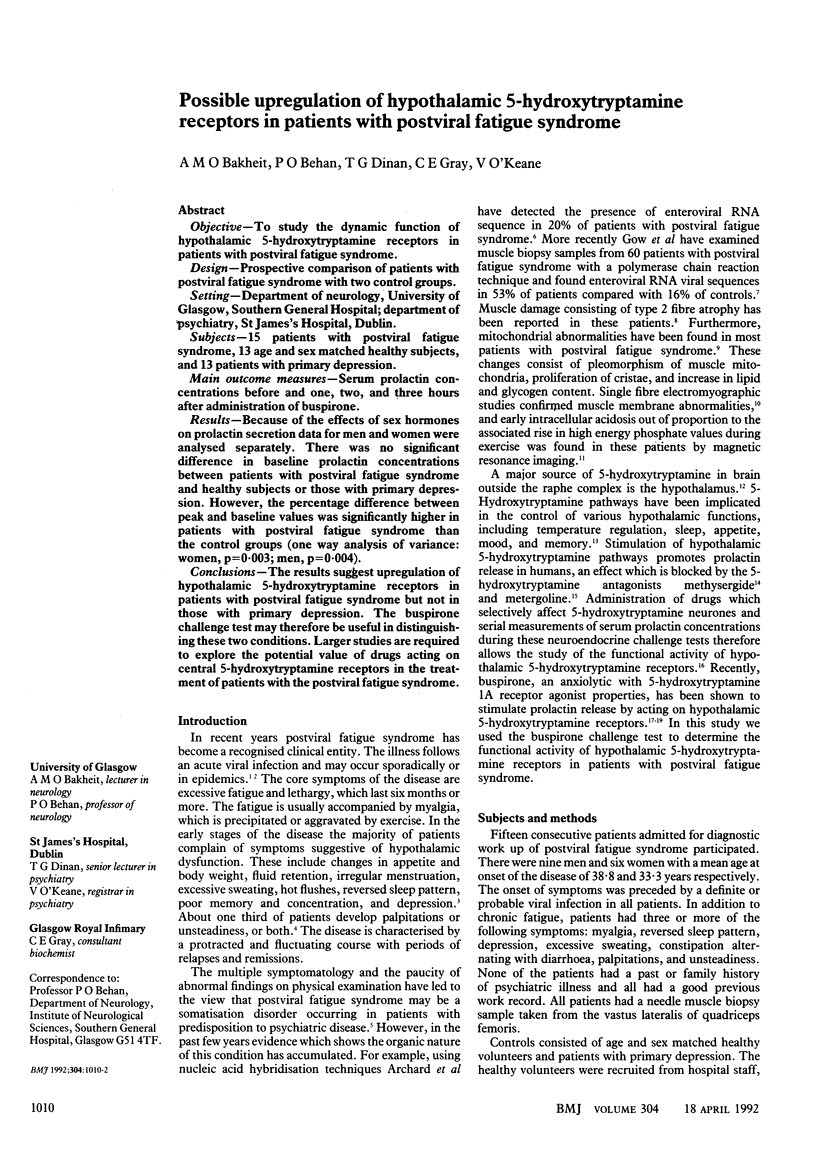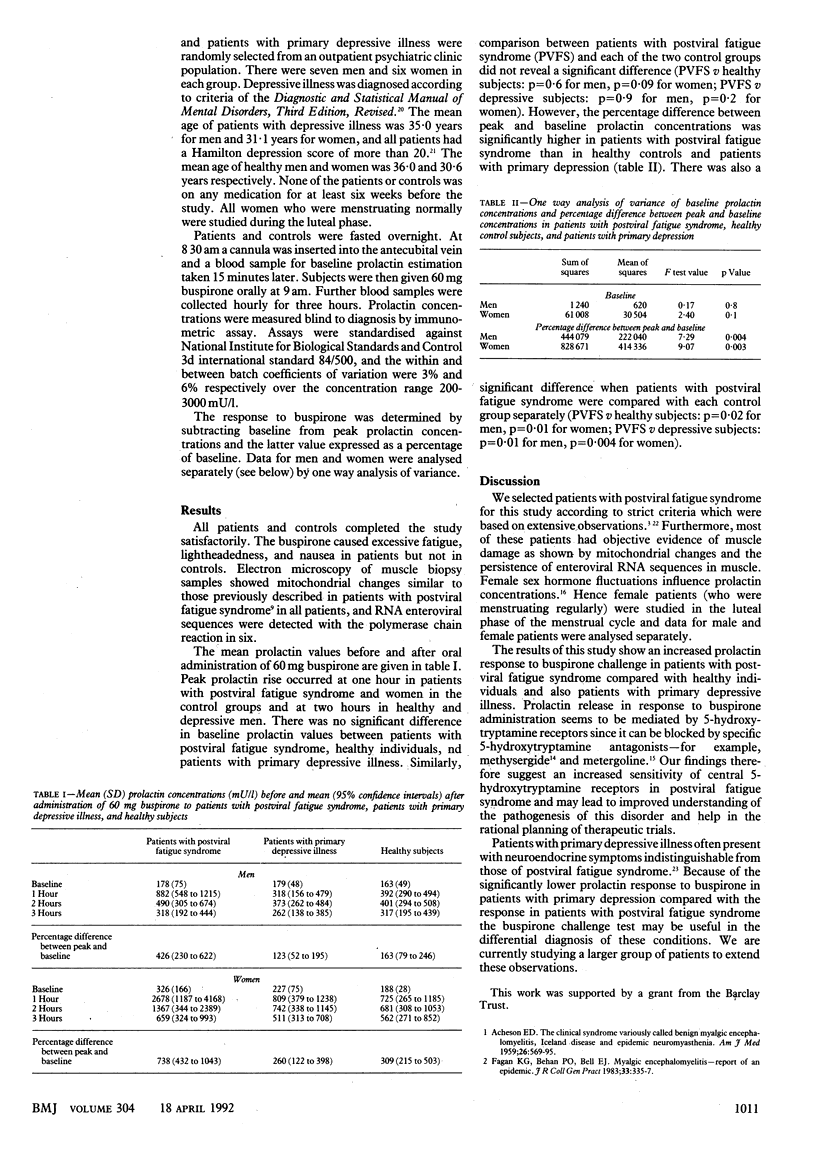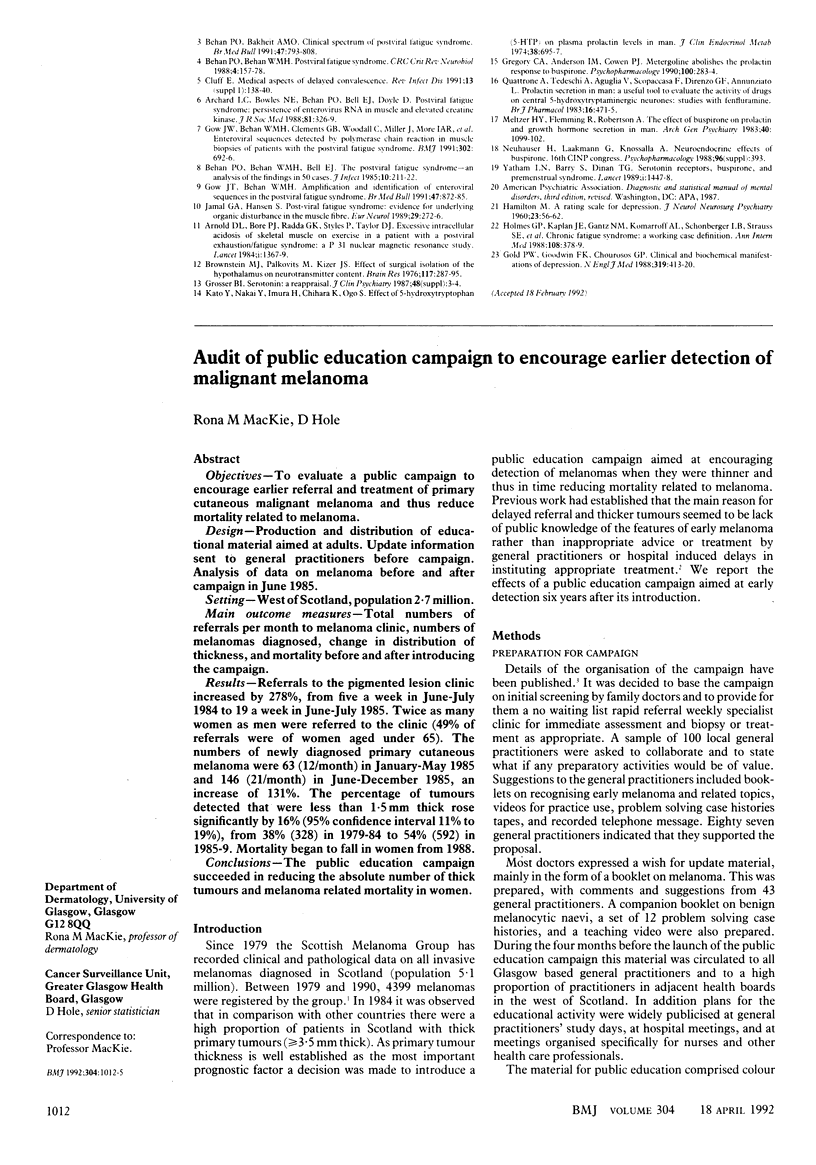Abstract
OBJECTIVE--To study the dynamic function of hypothalamic 5-hydroxytryptamine receptors in patients with postviral fatigue syndrome. DESIGN--Prospective comparison of patients with postviral fatigue syndrome with two control groups. SETTING--Department of neurology, University of Glasgow, Southern General Hospital; department of psychiatry, St James's Hospital, Dublin. SUBJECTS--15 patients with postviral fatigue syndrome, 13 age and sex matched healthy subjects, and 13 patients with primary depression. MAIN OUTCOME MEASURES--Serum prolactin concentrations before and one, two, and three hours after administration of buspirone. RESULTS--Because of the effects of sex hormones on prolactin secretion data for men and women were analysed separately. There was no significant difference in baseline prolactin concentrations between patients with postviral fatigue syndrome and healthy subjects or those with primary depression. However, the percentage difference between peak and baseline values was significantly higher in patients with postviral fatigue syndrome than the control groups (one way analysis of variance: women, p = 0.003; men, p = 0.004). CONCLUSIONS--The results suggest upregulation of hypothalamic 5-hydroxytryptamine receptors in patients with postviral fatigue syndrome but not in those with primary depression. The buspirone challenge test may therefore be useful in distinguishing these two conditions. Larger studies are required to explore the potential value of drugs acting on central 5-hydroxytryptamine receptors in the treatment of patients with the postviral fatigue syndrome.
Full text
PDF


Selected References
These references are in PubMed. This may not be the complete list of references from this article.
- ACHESON E. D. The clinical syndrome variously called benign myalgic encephalomyelitis, Iceland disease and epidemic neuromyasthenia. Am J Med. 1959 Apr;26(4):569–595. doi: 10.1016/0002-9343(59)90280-3. [DOI] [PubMed] [Google Scholar]
- Archard L. C., Bowles N. E., Behan P. O., Bell E. J., Doyle D. Postviral fatigue syndrome: persistence of enterovirus RNA in muscle and elevated creatine kinase. J R Soc Med. 1988 Jun;81(6):326–329. doi: 10.1177/014107688808100608. [DOI] [PMC free article] [PubMed] [Google Scholar]
- Arnold D. L., Bore P. J., Radda G. K., Styles P., Taylor D. J. Excessive intracellular acidosis of skeletal muscle on exercise in a patient with a post-viral exhaustion/fatigue syndrome. A 31P nuclear magnetic resonance study. Lancet. 1984 Jun 23;1(8391):1367–1369. doi: 10.1016/s0140-6736(84)91871-3. [DOI] [PubMed] [Google Scholar]
- Behan P. O., Bakheit A. M. Clinical spectrum of postviral fatigue syndrome. Br Med Bull. 1991 Oct;47(4):793–808. doi: 10.1093/oxfordjournals.bmb.a072511. [DOI] [PubMed] [Google Scholar]
- Behan P. O., Behan W. M., Bell E. J. The postviral fatigue syndrome--an analysis of the findings in 50 cases. J Infect. 1985 May;10(3):211–222. doi: 10.1016/s0163-4453(85)92488-0. [DOI] [PubMed] [Google Scholar]
- Behan P. O., Behan W. M. Postviral fatigue syndrome. Crit Rev Neurobiol. 1988;4(2):157–178. [PubMed] [Google Scholar]
- Brownstein M. J., Palkovits M., Tappaz M. L., Saavedra J. M., Kizer J. S. Effect of surgical isolation of the hypothalamus on its neurotransmitter content. Brain Res. 1976 Nov 26;117(2):287–295. doi: 10.1016/0006-8993(76)90736-8. [DOI] [PubMed] [Google Scholar]
- Fegan K. G., Behan P. O., Bell E. J. Myalgic encephalomyelitis--report of an epidemic. J R Coll Gen Pract. 1983 Jun;33(251):335–337. [PMC free article] [PubMed] [Google Scholar]
- Gold P. W., Goodwin F. K., Chrousos G. P. Clinical and biochemical manifestations of depression. Relation to the neurobiology of stress (2) N Engl J Med. 1988 Aug 18;319(7):413–420. doi: 10.1056/NEJM198808183190706. [DOI] [PubMed] [Google Scholar]
- Gow J. W., Behan W. M. Amplification and identification of enteroviral sequences in the postviral fatigue syndrome. Br Med Bull. 1991 Oct;47(4):872–885. doi: 10.1093/oxfordjournals.bmb.a072517. [DOI] [PubMed] [Google Scholar]
- Gow J. W., Behan W. M., Clements G. B., Woodall C., Riding M., Behan P. O. Enteroviral RNA sequences detected by polymerase chain reaction in muscle of patients with postviral fatigue syndrome. BMJ. 1991 Mar 23;302(6778):692–696. doi: 10.1136/bmj.302.6778.692. [DOI] [PMC free article] [PubMed] [Google Scholar]
- Gregory C. A., Anderson I. M., Cowen P. J. Metergoline abolishes the prolactin response to buspirone. Psychopharmacology (Berl) 1990;100(2):283–284. doi: 10.1007/BF02244420. [DOI] [PubMed] [Google Scholar]
- HAMILTON M. A rating scale for depression. J Neurol Neurosurg Psychiatry. 1960 Feb;23:56–62. doi: 10.1136/jnnp.23.1.56. [DOI] [PMC free article] [PubMed] [Google Scholar]
- Kato Y., Nakai Y., Imura H., Chihara K., Ogo S. Effect of 5-hydroxytryptophan (5-HTP) on plasma prolactin levels in man. J Clin Endocrinol Metab. 1974 Apr;38(4):695–697. doi: 10.1210/jcem-38-4-695. [DOI] [PubMed] [Google Scholar]
- Meltzer H. Y., Flemming R., Robertson A. The effect of buspirone on prolactin and growth hormone secretion in man. Arch Gen Psychiatry. 1983 Oct;40(10):1099–1102. doi: 10.1001/archpsyc.1983.01790090061009. [DOI] [PubMed] [Google Scholar]
- Quattrone A., Tedeschi G., Aguglia U., Scopacasa F., Direnzo G. F., Annunziato L. Prolactin secretion in man: a useful tool to evaluate the activity of drugs on central 5-hydroxytryptaminergic neurones. Studies with fenfluramine. Br J Clin Pharmacol. 1983 Nov;16(5):471–475. doi: 10.1111/j.1365-2125.1983.tb02202.x. [DOI] [PMC free article] [PubMed] [Google Scholar]
- Yatham L. M., Barry S., Dinan T. G. Serotonin receptors, buspirone, and premenstrual syndrome. Lancet. 1989 Jun 24;1(8652):1447–1448. doi: 10.1016/s0140-6736(89)90149-9. [DOI] [PubMed] [Google Scholar]


